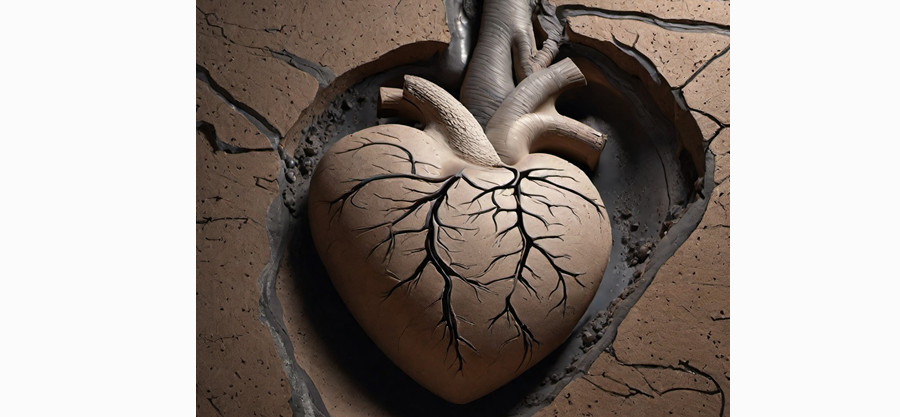Introduction
The heart, a vital organ that pumps life-sustaining blood throughout the body, is a marvel of biological engineering. But have you ever wondered how this intricate pump finds its place in the chest cavity? The answer lies in a complex process of development and positioning known as ‘Cardiac Ectopia or Ectopia Cordis.’ In this article, we will explore the fascinating journey of the heart as it finds its rightful place in the body.1,2
What is Cardiac Ectopia? 1,2
Cardiac Ectopia is an exceptionally rare genetic anomaly where the heart is unusually positioned either partially or completely outside the chest cavity. Normally, the heart resides within the chest, nestled between the lungs. However, in ectopia cordis, the heart develops partly or fully outside this space. This condition can involve chest (thorax), abdomen, or both irregularities. In most instances, the heart protrudes beyond the chest, extending through the sternum or breastbone. Regrettably, this congenital disorder is predominantly fatal, and newborns with this condition hardly survive for more than a few hours or days.
Ectopia Cordis develops when the chest wall fails to join properly during the baby’s growth in the mother’s womb. The disorder prevents the heart from growing normally, exposing it outside the chest wall.
In partial ectopia cordis, the heart resides outside the chest wall but beneath the skin. Doctors can observe the heart beating through the skin in newborns with this disease. In complete ectopia cordis, the heart lies fully outside the chest with only a thin layer of skin covering it.
Ectopia cordis is categorized into four types based on the heart’s location:
- Cervical
- Thoracic
- Thoracoabdominal ectopia
- Abdominal ectopia
Symptoms of Ectopia Cordis2
Ectopia cordis is primarily characterized by the heart being located outside the body. Infants with this condition often exhibit additional “midline defects” affecting the central body axis from head to groin, such as:
- Cranial cleft (a division in the baby’s facial structure)
- Cleft lip/palate (a division in the baby’s upper mouth)
- Underdeveloped lungs
- Scoliosis (curved spine)
- Anomalies in the diaphragm, the muscle separating the chest and abdomen.
Factors Leading to Ectopia Cordis3
Further research is needed to investigate the potential causes of ectopia cordis. This congenital condition originates during fetal development and is present from birth.
The sternum, or breastbone, is a crucial, flat bone connecting to the ribs and forming the front of the rib cage. It serves as protection for the heart and lungs. When the development of the breastbone is compromised in a developing fetus, it can result in the heart growing outside the chest since the rib cage cannot contain it.
Ectopia cordis can also manifest in other areas of the body, such as the abdominal wall and diaphragm, as part of an unusual condition known as the pentalogy of Cantrell. In these cases, these structures do not develop typically either.
How is Ectopia Cordis Treated?
Newborns born with this condition often require intense care, including incubation and respirator assistance. Doctors may use sterile dressings to shield the heart. Antibiotics are essential to prevent infections.2
In certain cases, surgeons may try to move the baby’s heart back inside the chest and close it up. This surgery can be challenging, especially if the baby has multiple severe problems.2,3
Doctors typically conduct these surgeries in phases. Initially, the heart is repositioned, and the chest wall issue is addressed. A temporary closure, often with synthetic materials, is crafted. Additional surgeries might be necessary to correct other heart or abdominal wall problems. Subsequent surgeries may involve bone and cartilage grafts for chest wall reconstruction. Ensuring the heart’s protection during all procedures is paramount.3
Conclusion
In the first 12 weeks of pregnancy, women must have a neonatal scan to detect congenital conditions like ectopia cordis. If a woman decides to terminate the pregnancy, the doctor should offer support and guidance for this difficult decision. Infants who undergo initial surgery and survive will require further surgeries and lifelong medical care. As research and treatment methods continually advance, there’s hope for a better future for infants diagnosed with ectopia cordis. The journey of the heart, evolving from a simple tube to its rightful place within the chest, showcases the marvels of human development. Although cardiac ectopia can bring challenges and health issues, medical science and technology progress, allowing for effective diagnosis and management of these conditions. As we delve deeper into the mysteries of embryogenesis and cardiac development, we gain a profound admiration for the remarkable complexity and resilience of the human heart.1,2,3
What would be the initial diagnostic steps for identifying ectopia cordis, doctors?
References
- Celik Y, Hallıoglu O, Basut N, Demetgul H, Esin Kibar A. A rare case of cardiac anomaly: prenatally diagnosed ectopia cordis. Turkish Archives of Pediatrics. 2015 Jun 1;50(2):129-31. DOI: 10.5152/tpa.2015.927. PMID: 26265899; PMCID: PMC4523987.
- What is Ectopia Cordis? (Accessed 06 Sep 2023). Available at: https://www.webmd.com/baby/ectopia-cordis-overview
- Radswiki T, El-Feky M, Glick Y, et al. Ectopia cordis. Reference article, Radiopaedia.org (Accessed 06 Sep 2023) https://DOI.org/10.53347/rID-12732




